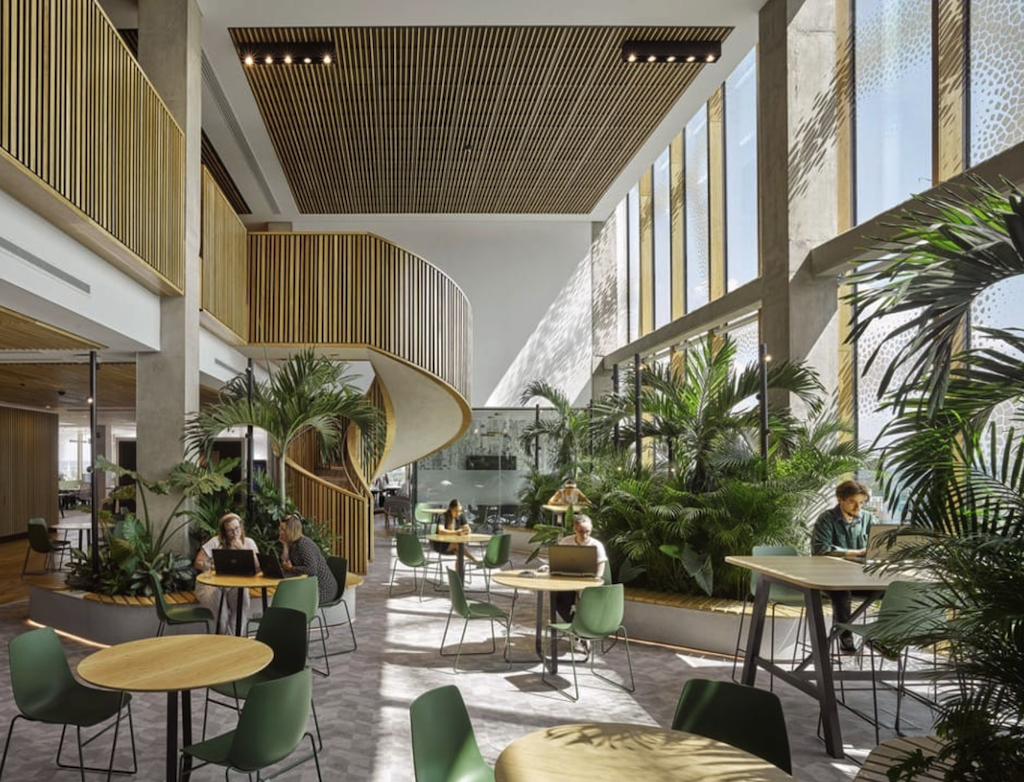Architecture
Wellness Is the New 'Why' In Neighborhood Development
Health and well-being are no longer add-ons—they’re the foundation of value, purpose, and performance in new communities. From brain-friendly design to AI-native living, five big trends are redefining what home means now.

How do you define (and measure) wellness? And what does it really mean for real estate? At every housing industry event since the COVID-19 pandemic, leading voices have spoken about the growing importance of wellness to housing choice. Ever since “improves my health and wellness” popped up as the top motivator for people choosing certain features and technologies in their homes in wave three of the America at Home Study, I’ve been saying wellness is the new “why.”
The Global Wellness Institute (GWI) defines wellness this way:
The active pursuit of activities, choices, and lifestyles that lead to a state of holistic health.”
The notion crosses and binds multiple dimensions: physical, environmental, social, emotional, mental, and spiritual. Since publishing the first Global Wellness Economy Monitor in 2014, the GWI has studied the annual global growth of the wellness economy across 11 sectors, comprising industries that enable consumers to incorporate wellness into their daily lives.
In 2024, the global wellness economy was valued at $6.3 trillion, more than 25% higher than in 2019. Since the pandemic, the wellness economy has had an average annual growth rate of 5.9%, significantly faster than the global GDP growth rate of 4.6%.
Wellness real estate is the fastest-growing sector, with an average annual growth rate of 18.1% from 2019-2023 and a value of $438 billion in 2024. According to GWI data, there are no signs of slowing down. The macro global wellness economy is projected to grow by 7.3% annually through 2028, while wellness real estate is projected to grow by 15.8% annually during that same period.
GWI’s Wellness Communities & Real Estate Initiative — which I co-chair with Jean-Francois Garneau, chief development officer of INITIAL Real Estate, a developer, planner, and strategist based in Geneva, Switzerland — identifies and reports on wellness real estate trends annually. With the growth trajectory and consumer demand shooting off the charts, five trends this year are particularly salient.
Trend 1: Brain-friendly buildings
This one is about the growing integration of neuro-architecture for mind wellness and the recognition of how buildings help or hinder mental wellness.
Developers and design teams increasingly embrace neuroscience to create environments that promote mental clarity, emotional resilience, and overall well-being. Neuro-architecture and “brain-friendly buildings” integrate biophilic design, circadian lighting designed to mimic natural light cycles and regulate physiological functions, and attention to acoustics and other sensory elements as foundational features, not afterthoughts.

Iconic examples like The Spine building in Liverpool, with its anchor tenant, the Royal College of Physicians, showcase innovations like light-adaptive workspaces, integrated greenery for better air quality, and mindfulness zones to reduce stress. Residential applications are gaining traction with restorative layouts and environments that improve focus, and integrate indoor and outdoor spaces for a deeper connection to nature and community.
Why This Matters
- Improved Productivity and Happiness: Biophilic design and optimized lighting can increase cognitive performance, reduce stress, and improve emotional well-being.
- Mental Health Priority: Tenants and buyers are willing to pay premiums for spaces that improve their quality of life.
- Aging Population: With dementia rates doubling every five years after age 65, neuroscience-driven environments could support cognitive health and improve longevity.
- Market Differentiation: Neuro-architecture positions developments as leaders in an increasingly competitive, health-focused market.
Trend 2: Smart wellness ecosystems
What if your house was your wearable?”
This may sound far-fetched, but its bold vision is now more plausible than even a year ago.
By integrating AI, IoT, and wellness design, homes can actively learn and adapt to people’s needs—monitoring air quality, sleep patterns, the freshness of food in the refrigerator, and energy consumption while suggesting personalized health improvements. These technologies proactively enhance well-being while optimizing resource use, which reduces the home's ongoing operating costs.
Beyond individual homes, this trend extends to digitally connected communities. Wellness platforms integrate shared amenities, virtual fitness classes, and mental health resources, connecting residents to networks that foster social bonds and collaboration. Future innovations will focus on improving the accessibility and usability of wellness data to drive further design improvements and operational efficiencies and potentially even impact the cost and availability of health insurance.
Why This Matters
- Health Innovation: AI-powered homes and connected communities enhance health outcomes and lower operational costs for occupants.
- Market Demand: Buyers are willing to pay more for proactive wellness features that improve quality of life and reduce resource consumption and costs.
- Reduced Turnover: Connected ecosystems promote belonging, leading to happier tenants and lower churn rates.
- Higher Valuations: Smart wellness features increase property appeal, driving higher rents and resale prices, as shown in a report from the UN Environment Programme’s Finance Initiative and the Center for Active Design.
Trend 3: Live, work, zen — wellness takes main stage
Developers are designing communities with wellness as their foundation from the beginning, with as much attention paid to wellness as traditional infrastructure.
Mixed-use developments are evolving into wellness hubs, where residential, commercial, and recreational spaces are seamlessly integrated, and wellness consultants, designers, and developers cooperate across asset classes, leveraging their collective strength from initial project conception to financing, to partnerships, to space design, and even programming. These developments prioritize wellness infrastructure like walkability, green spaces, social connections, healthy food access, fitness centers, micro-mobility, and access to healthcare, creating environments designed to promote holistic well-being, with specific consideration to their evolution over time, just like we used to think about infrastructure.
Why This Matters:
- Holistic Living: Communities that integrate work, leisure, and health improve overall well-being.
- Market Demand: Younger generations increasingly prioritize wellness amenities and connected living.
- Sustainability: Walkable, car-free developments support environmental goals while fostering healthier lifestyles.
- Faster Lease-Ups: These projects attract buyers and renters faster, creating stronger financial returns.
Trend 4: Gen Alpha approved—homes for AI Natives
Embrace bio-adaptive living for the most tech-savvy generation yet.
We design today with the future in mind in homebuilding and community development. For Gen Alpha — the first fully AI-native generation and one facing more significant housing affordability challenges than previous generations — that future includes bio-adaptive living that prioritizes modular, flexible, and multifunctional designs to make homes work harder for the people living in them. Features like retractable walls, foldable or hidden furniture, and dual-purpose areas allow spaces to transform seamlessly between different uses, catering to the needs of dynamic households.
Bio-adaptive hybrid flexible spaces, rather than single-purpose rooms that adapt to natural biological processes, environmental conditions, and wellness-focused smart tech integration, will become standard expectations for Gen Alpha’s “phygital” lifestyle. They expect homes to blend the best physical and digital experiences and align with their needs and lifestyles that prioritize mental and physical wellness.
Why this matters:
- Generational Impact: Designing for Gen Alpha influences housing trends for decades.
- Future-Proofing: Modular, tech-forward homes ensure adaptability to changing needs, use fewer resources, and leverage investments to go further.
- Market Appeal: Wellness-focused, hybrid spaces attract premium buyers and will result in these innovations becoming mainstream.
- Space Optimization: Features like sliding partitions, lofted beds, and convertible furniture unlock maximum utility even in small spaces, essential to housing affordability.
Trend 5: “Placekeeping” and Placemaking Converge
Keeping an eye on the past and an ear to the future responds authentically to the best of both.
Placemaking — intentional or not — has often catalyzed gentrification and privileged dominant cultures, overshadowing a place's unique character and nature at the expense of social well-being. Regionally responsive architecture that connects people to their existing places, communities, and cultures is critical to honoring a location's uniqueness and pride.
Financial engineering drove much of 20th-century real estate development, where designers followed codified, bureaucratized, and homogenized ideas about what a place "should" become, often without fully honoring or understanding communities and social connections already there.
The convergence of placemaking with the principles of authentic “placekeeping” respects existing characteristics, cultures, and social connections, and involves collaborative design with, not for, stakeholders. This approach results in more resilient, socially connected, and authentic places where people can thrive.
Why This Matters:
- Homogenization of the Built Environment: The commodification of spaces has led to real estate development that often disregards cultural history and community needs.
- Integration of Existing Infrastructure: Both social and physical infrastructure can be more effectively leveraged, reducing resource waste and improving resilience.
- Addressing Inequity: Prioritizing placekeeping reduces the wealth and wellness gap caused by developments that favor privileged groups.
- Cultural Relevance: Honoring the cultural and social characteristics of a place creates stronger emotional connections with end users, leading to higher satisfaction and longer occupancy rates.
These trends, new technologies, and how evidence-based wellness creates value in real estate will be the subject of the GWI’s fourth annual Wellness Communities & Real Estate Symposium in New York City on June 17.
MORE IN Architecture
Integration Has Pivoted Into Homebuilding’s Survival Skill
Higharc’s "linked options" are pre-defined combinations of home features that account for all dependencies between design, materials, and pricing. Once defined, they automatically populate across all systems, reducing error and time-to-quote.
Florida Condo Project Sets Resilience Benchmark Early
Contributing writer Richard Lawson explores the challenges – and an urgent lane of future-proof opportunity for residential developers – in an exclusive interview with John Farina, president of U.S. Development.
AI Crushes Missing-Middle Time And Cost Curves Toward Affordability
Developing multifamily rental and for-sale properties takes time — sometimes years -- depending on a labyrinth of zoning rules and the whims of local jurisdictions.
